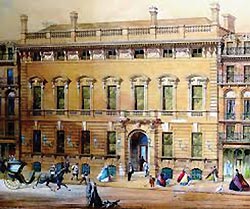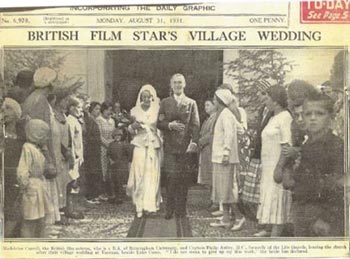|
THE OTHER GUARDS CLUB
by Christopher Joll
formerly The Life Guards
|
 Garrick Club
Garrick Club |
In the halcyon days when the Guards Club still had its own premises in Charles Street, it was accustomed during the annual summer closure to offer its members a reciprocal arrangement with, amongst others, the Garrick Club in Covent Garden. This is the institution whose salmon pink and cucumber green tie is almost as well know as its membership, which is drawn principally from the worlds of the theatre, the law and those who live by the output of their pens.
The motto of the Club, founded in 1831, is ‘All the World’s A Stage’ but it could just as well be ‘The Pen is Mightier Than the Sword’, as evidenced by a remark overheard by the author whilst loitering by the members’ notice board in the summer of 1976.
First member: ‘I see that we’re hosting the Guards Club this summer.’
Second member: ‘Oh, dear! Oh, dear! All those brutal faces…’
From this story, it is reasonable to conclude that the Garrick Club, despite having had no less than six Victoria Cross holders amongst its past members, is not the natural home of the military.
But it has not always been thus, for it is a recorded fact that it was Major General Sir Francis Barnard, a Grenadier and Waterloo veteran, who planned the Garrick’s foundation with Samuel Arnold, Samuel Beazley and Francis Mills at a meeting held in the Drury Lane Theatre on 17th August 1831, and in the period 1831-1870, it could be argued that the Garrick was the louche annex of the service clubs, for a third of its members were serving or retired soldiers and sailors of whom fifty-six were either Guardsmen or Household Cavalrymen.
 Major General Sir Francis Barnard
Major General Sir Francis Barnard |
 Marquess of Headfort
Marquess of Headfort |
These early Garrick-Guardsmen, in addition to Barnard, included founder member Field Marshal the Marquess of Anglesey, Colonel of The Blues, who was the cavalry commander at Waterloo and famously lost his leg towards the end of the battle (another Paget, this time from the seafaring branch of the family, was Admiral the Lord Alcester, who joined the Garrick in 1848 and, by reason of his acute dress sense, was wittily known as the ‘Ocean Swell’).
Although The Duke of Wellington declined an invitation to be a founder member, in the first forty years of the Garrick’s existence, fourteen 1st Life Guards, eleven 2nd Life Guards, seven Blues (in addition to Lord Anglesey), thirteen Grenadiers, nine Scots Fusilier Guards, and a lone Coldstreamer were members of the Club. Somewhat surprisingly, Major General the Earl of Cardigan (of Charge of the Light Brigade fame), a notorious snob and womaniser who later lobbied (unsuccessfully) to be Colonel of the 1st Life Guards, was also a founder member and probably a rather uncongenial one at that.
In the last quarter of the nineteenth and the first quarter of the twentieth centuries, Household troops continued to be well-represented in the list of Garrick Club members, with a further forty-two Foot Guards (including three Micks) and ten Household Cavalrymen adding the Club’s salmon and cucumber tie to their blue-red-blue neckwear.
The reason for the Club’s popularity with members of the Household Brigade and the Household Cavalry prior to the Great War is not, however, immediately apparent, as there is no direct connection, despite the histrionic abilities of many Generals, between the worlds of warfare and the stage. That said, over the years many Guardsmen have gone on to become ‘stars’ in the fields of the arts most closely associated with the Garrick Club and, as detailed in The Drum Horse in the Fountain (Christopher Joll & Anthony Weldon, Nine Elms Books), their number includes Oscar winners, actors, directors, producers, writers and poets. But few of them were members of the Club, so that cannot be the reason.
 Captain Philip Astley marries Madeleine Carroll
Captain Philip Astley marries Madeleine Carroll |
Given that the Garrick was not primarily a club for actors, rather (as its founding Articles state) to ‘tend to the regeneration of the Drama’, the probable reason for the relatively high number of Guards officer members at that time was because, stationed in and around London, they were frequent and enthusiastic theatre-goers. They were also notorious ‘Stage Door Johnnies’ and numbered many actresses amongst their mistresses although not, before the Great War, amongst their wives: Lieutenant George Charles Fitzwilliam (the father of the last Earl Fitzwilliam) was obliged to resign from The Blues in 1888 when he married Daisy Lyster of the Gaiety Theatre’s chorus line; Lieutenant the Marquess of Headfort was forced to resign from the 1st Life Guards in 1901, when he married the actress Rosie Boote; and Lord Edward FitzGerald of the Irish Guards, who in 1913 proposed to marry May Etheridge, otherwise known as the ‘Pink Pajama Girl’, a beautiful (but very minor) star of the variety stage at the Shaftesbury Theatre, was required to resign his commission in the Micks before he tied the knot with his pink pajama’d girl. Significantly, no objection was raised after the Great War when, in 1931, the dashing Captain Philip Astley of The Life Guards married Madeleine Carroll, at the time the highest paid film star in the world; although it is probable that the then Gold Stick, Field Marshal the Viscount Allenby, would have had words with Astley had he proposed marrying his previous mistress, the ex-chorus girl turned West End star, Gertrude Lawrence.
 Field Marshal the Lord Guthrie
Field Marshal the Lord Guthrie |
Nonetheless, and despite its previous popularity, after the Second World War the Garrick Club appeared to fall out of favour with the Household Brigade and the Household Cavalry with only two Blues, a Grenadier, a Coldstreamer and a Welsh Guard joining prior to 1970. There is no immediately apparent reason for this decline, unless it was that the Second World War not only saw the destruction of many London theatres but also the death of the ‘Stage Door Johnny’.
Today there remains a distinct absence in the Garrick’s bar of those highly polished toe caps which still denote a Guardsman and there are only seven former members of the Household Division in the 2018 List of Members, including HRH The Duke of Edinburgh who is the Patron of the Club. Not amongst their number is Field Marshal the Lord Guthrie, formerly of the Welsh Guards and The Life Guards, despite the fact that as a young officer he trod the boards of the Royal Opera House, Covent Garden, carrying a spear in a 1960s production of Aida – a duty which, along with his published works, fully qualifies him for membership of ‘the other Guards Club’
|
|





